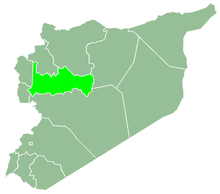| Siege of Hama (2011) | |
|---|---|
| Part of the Syrian revolution | |
 | |
| Location | |
| Target | Opposition protesters |
| Date | 3 July[1][2] – 4 August 2011[3] (1 month and 1 day) |
| Executed by | |
| Outcome | Protests suppressed |
| Casualties | 16 civilians killed in early July 2011[1] 200 civilians killed during Ramadan offensive[3] Total: 216+ killed |
The 2011 siege of Hama was among the many nationwide crackdowns by the Syrian government during the Syrian revolution, the early stage of the Syrian civil war. Anti-government protests had been ongoing in the Syrian city of Hama since 15 March 2011, when large protests were first reported in the city,[4] similar to the protests elsewhere in Syria. The events beginning in July 2011 were described by anti-government activists in the city as a "siege"[5] or "blockade".[6]
On 1 July, with more than 400,000 protestors, Hama witnessed the largest demonstration against President Bashar al-Assad.[2] Two days later, government tanks were deployed at Hama,[7] in an operation that led to more than 16 civilian deaths at the hands of Syrian security forces.[1]
On 31 July, the Syrian government deployed the Syrian Army into Hama to control protests on the eve of Ramadan, as part of a nationwide crackdown, nicknamed the "Ramadan Massacre."[8] At least 142 people across Syria died on that day, including over 100 in Hama alone, and 29 in Deir ez-Zor. Hundreds more were wounded.[9][10] By 4 August, more than 200 civilians had been killed in Hama.[3]
- ^ a b c "Syrian forces in deadly assault on Hama - Middle East". Al Jazeera English. 5 July 2011. Retrieved 3 August 2011.
- ^ a b "Syria: 'Hundreds of thousands' join anti-Assad protests". BBC. 1 July 2011. Retrieved 3 August 2011.
- ^ a b c Bakri, Nada (4 August 2011). "Civilian Toll Is Mounting in Assault on Syrian City". The New York Times. Retrieved 5 August 2011.
- ^ "Syria: President Bashar al-Assad sacks governor of Hama". BBC News. 2 July 2011. Retrieved 28 October 2020.
- ^ "France-Diplomatie". Diplomatie.gouv.fr. Archived from the original on 31 December 2011. Retrieved 3 August 2011.
- ^ "Syrian protesters demand end of Hama blockade". Alarabiya.net. 7 July 2011. Archived from the original on 29 July 2018. Retrieved 3 August 2011.
- ^ "Syrian tanks deploy at Hama after large protest". Reuters. 3 July 2011. Retrieved 3 August 2011.
- ^ Samuelson, Robert J. (2 August 2011). "Syria's Ramadan massacre". The Washington Post.
- ^ AFP (31 July 2011). "Syrian army kills at least 95 in Hama: activist". Dawn.Com. Retrieved 3 August 2011.
- ^ "Hama assault into second day, UN revives Syria debate". Khaleejtimes.com. Archived from the original on 2 October 2012. Retrieved 3 August 2011.